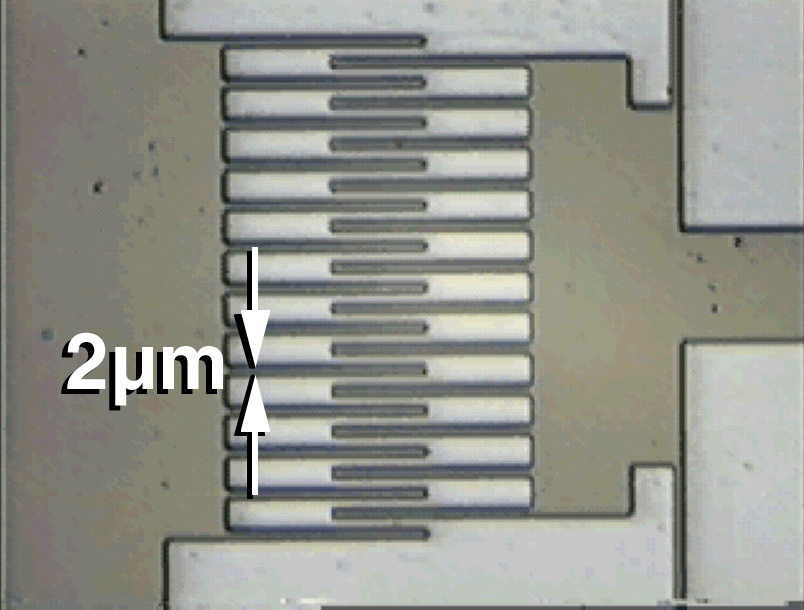
Download 300dpi JPEG image, ‘ADcomb.jpg’, 155K (Media are welcome to download/publish this image with related news stories.)
ALBUQUERQUE, N.M. — You can’t give them to your loved one on Valentine’s Day, and they are much too small to be a girl’s best friend, but Sandia National Laboratories has created what are believed to be the world’s first diamond micromachines.
The machines at the Department of Energy’s national security facility are etched from a surface of amorphous diamond, the hardest material in the world after crystalline diamond in a manner compatible with current silicon chip and surface micromachine manufacturing techniques.
Diamond interests researchers because of its superior wear-resistant qualities, resistance to stiction — a combination of stickiness and friction — and potential as a biocompatible material that could be used inside the human body for medical purposes without generating an allergic reaction.
Currently constructed is a diamond comb drive whose tiny interspaced teeth move forward and back as an electrical current reverses constantly between positive and negative. This is the first demonstration of a micro-motion drive using amorphous diamond.
The point, say researchers John Sullivan and Tom Friedmann, is to create a layering technology useful in increasing the life span and performance of micromachines.
Says Friedmann, “Micromachines, for their marvelously tiny size, are still machines. They’re subject to wear, even if it’s only at the micro level. Diamond is more wear-resistant than polysilicon. One estimate in the literature claims that diamond should last 10,000 times longer than polysilicon in wear applications. Our material is chemically benign and compatible with silicon. It could function as another station in the line in the creation of a basically silicon micromachine, but with a diamond layer for additional strength and durability. It could one day be used as a complete replacement for polysilicon.”
Silicon MEMs (MicroElectroMechanical Systems) are already used in a variety of applications ranging from air bags in cars to optical micromirrors slated for possible deployment on satellites.
There are two kinds of diamond, crystalline and amorphous. The Sandia researchers use amorphous diamond, the hardest substance known to science after crystalline diamond. Crystalline is currently impractical because of the far higher temperatures needed to synthesize it and the surface roughness that precludes its use in a multilayer surface micromachine technology.
Amorphous diamond itself had been impractical because its tremendous internal stresses — hundreds of atmospheres — formerly had made it impossible for the material to stand alone or to coat thickly any but the strongest substrates. However, a process developed previously by Friedmann and Sullivan eliminates that problem.
Also, diamond reduces stiction when compared with silicon. (Stiction is a tendency for an object resting on another to stick, rendering devices useless.) This is because, says Sullivan, while silicon is hydrophilic and therefore attracted to water that may be present in the atmosphere, diamond is not. Water molecules, at such small scales, act as a kind of glue.
Another advantage, says Friedmann, is that diamond is a biocompatible material, so that it could be used in the body as a drug-dispensing unit without initiating an allergic reaction. “Carbon [the elemental ingredient of diamond] is chemically benign,” he says.
The millimeter-square drive consists of two diamond combs on a flat surface, teeth facing each other. One comb is bolted down. The other moves freely within the confines of a spring. A diamond rod attaches to the spine of the moveable comb. When an electric voltage to the comb repeatedly cycles from positive to negative, the teeth alternatingly attract and repel each other. This moves a comb back and forth and makes work — like driving a gear — achievable.
The laboratory devices, funded by Sandia’s Laboratory-Directed Research and Development Office, are estimated by researchers to be marketable on their own in about five years.
Currently, the proof-of-principle devices take three hours for diamond to deposit through pulsed laser deposition. Annealing the diamond so that it has zero stress (to prevent warpage) can be done in minutes.
Putting a machine specifically assigned to add a layer of amorphous diamond into the clean room in an otherwise-silicon fabrication facility is achievable, since diamond is chemically compatible with silicon, the researchers believe. Such machines may soon become commercially available.